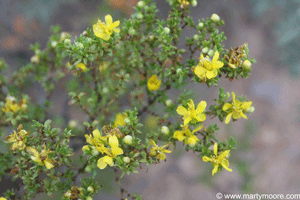Creosote Bush, Larrea tridentata, is a common shrub in the desert Southwest, found below 5,000 feet of elevation.
The shrub has waxy small leaves and yellow flowers, followed by whitish fuzzy seed pods.
Usually about 4 or 5 feet high, but can grow higher with more water.
Full sun and very low water requirements.
If you walk in the desert after a rain, you should notice a strange smell coming from the creosote bush, some people believe it smells like urine and others actually like it.
The Spanish word for the plant, hediondilla, means "little stinker," so not everyone finds the odor a "heavenly essence of the desert".
The leaves of the Creosote Bush are coated with a resin which helps the plant retain water and protects it from being eaten by most desert animals. Jackrabbits are the only mammal known to eat the creosote bush, but only if nothing else is available.
There is some speculation that the roots secrete a toxic substance which inhibits the growth of nearby plants.
Creosote Bush is great as a very drought tolerant plant for the Xeriscape or desert landscape, if you can stand the odor!
Back to list of Shrubs

